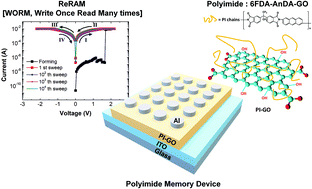High-performance non-volatile resistive switching memory based on a polyimide/graphene oxide nanocomposite†
Abstract
Graphene oxide (GO) modified with 2,6-diaminoanthracene (AnDA) (GO-AnDA) is prepared and characterized. Poly(amic acid)-GO (PAA-GO) is prepared by the reaction of 4,4′-(hexafluoroisopropylidene)diphthalic anhydride (6FDA) with AnDA in the presence of GO-AnDA. Polyimide-GO (PI-GO) nanocomposites with different GO contents are prepared by chemical imidization of the PAA-GO, and characterized by Fourier transform infrared (FT-IR) spectroscopy, thermogravimetric analysis (TGA), differential scanning calorimetry (DSC), high resolution X-ray diffraction (HR-XRD), atomic force microscopy (AFM) and UV-visible spectroscopy. PI-GOs show high thermal decomposition temperatures around 500 °C and glass transition temperatures (Tgs) around 400 °C. Al/PI-GO/ITO memory devices are fabricated using PI-GO films as a resistive active layer. The memory device fabricated with PI-GO film containing 1.5 wt% GO exhibits write-once-read-many-times (WORM) memory behavior with an excellent ON/OFF ratio (∼108), long retention time (∼104 s), good endurance (104th cycle), and an outstanding yield (92%). Post-annealing of the memory device improves the performance of the memory device. The mechanisms associated with the memory effect are explained from electron density difference map (EDDM) calculations. This study demonstrates that the PI-GO nanocomposite is a suitable active material for low-cost solution processing of next-generation nonvolatile memories.



 Please wait while we load your content...
Please wait while we load your content...